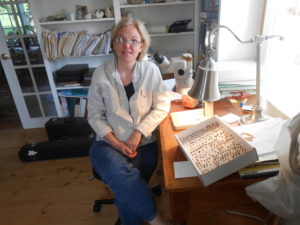
Applied Entomologist Sara Bushmann studies bees and other pollinators — bugs that help plants grow.
What’s your favorite kind of insect? Why?

Without bees, bumblebees, and other insects flying from flower to flower, spreading pollen, many plants, including blueberry bushes, would not be able to make the food we eat. Scientists have studied these pollinators for many years, noting that the fruit yields of flowering plants can depend on them.
Applied entomologist Sara Bushmann connects her love of the natural world with experiences she had as a child.One of Sara’s favorite childhood pasttimes was to search for ants while exploring wooded environments.She liked to experiment by blocking their paths with sticks and observing how the ants dealt with the obstruction.Every week, Sara watched nature shows with her parents at their home in Jefferson, Missouri, particularly enjoying primatologist Jane Goodall’s shows.She and her parents read books by Goodall, astronomer Carl Sagan, and other scientists, and Bushmann pored over the books that were part of a nature encyclopedia. When she vacationed with her family in the northern Minnesota woods every summer, she fed and named chipmunks, observing their behavior and looking for distinctive characteristics “like Jane Goodall did with her chimps.”
While completing her doctorate in entomology at the University of Maine, Bushmann collected 4,474 wild bees that represent 133 species in blueberry fields. Most of these species are native to the United States, but a few may have origins outside North America.They range from large and conspicuous bumblebees to tiny metallic-colored bees that are only about one centimeter long.Most of the bees she caught are sweat bees, which can be a bright, fluorescent green.The majority of the bees she caught on blueberry flowers, bees which carry blueberry pollen, were of the genus Andrena.These “mining bees” are larger, black bees who nest in the ground.Bumblebees and andrenid bees help pollinate blueberry plants’ flowers.If the flowers aren’t pollinated, they won’t produce berries.So the work these bees do can make the difference between good harvests and poor ones for Maine’s blueberry farmers.
To catch her bees, Bushmann spray-paints plastic cups florescent yellow and blue, leaving some of them white.A few species tend to fly into yellow cups, while others choose blue or white the most often.Most bees don’t seem to prefer one color over another,but scientists have found that they catch the most bees by filling all three colors of cups with soapy water. Bushmann uses a drop of Dawn to break up the water’s surface tension, so the bees don’t just walk across it and fly away.
Monoculture (growing just one crop over a large area), using chemicals to kill weeds and insect pests, and cutting down hedge rows where pollinators might nest (or rest) has reduced the numbers of wild bee pollinators.Honeybees (imported to the U.S. by colonists and raised by beekeepers) have also been dying off in large numbers. Think of honeybees as cows, says Bushmann. “They are really essentially livestock,” trucked around the country to pollinate almonds in California and then blueberries in Maine, among other crops and regions of the country.
With numbers of native (wild bees and bumblebees) and domesticated (honeybees) playing such an important role in the success of blueberry farming, Bushmann decided it would be important to figure out which species might be the best and most common pollinators. While some of her colleagues explored the largest fields of Maine’s biggest growers, Bushmann preferred to explore the smaller fields owned by 75% of Maine’s blueberry farmers.She counted honeybees but focused her efforts on local, wild bees like the sweat bee, mining bee, and bumblebee.
As she works, Bushmann uses algebra and concepts she learned while studying geometry as well. What percent of a blueberry field provides insects with “nonblueberry floral resources”? To find the answer to this question, Bushmann counts blueberry flowers and also flowers from nonblueberry plants, measuring out a circle with a radius of one meter and using the flowers within the circle as a sample. She collects data and analyzes and shares it with graphs.Statistics help her determine which conclusions seem reasonable. “You need to be able to know why you’re doing something and what the numbers mean,” she says, pointing out that there’s no answer key to help guide scientists in the field and theorists drawing conclusions from the data they gather.
Says Bushmann, “Using my feet to explore a field and a microscope to examine a bee, I can learn a lot about the smaller parts of the natural world that many of us often walk by without noticing.”


